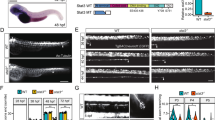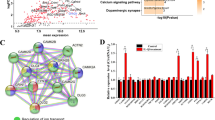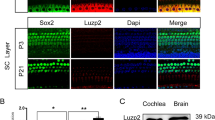Summary
Superoxide dismutase 2 (SOD2)-mediated gene therapy has significant protective effects against kanamycin-induced hearing loss and hair cell loss in the inner ear, but the underlying mechanisms are still unclear. Herein, an in vivo aging model of mitochondrial DNA (mtDNA)4834 deletion mutation was established using D-galactose, and the effects of noise or kanamycin on inner ear injury was investigated. Rats subjected to mtDNA4834 mutation via D-galactose administration showed hearing loss characterized by the disruption of inner ear structure (abnormal cell morphology, hair cell lysis, and the absence of the organ of Corti), increased SOD2 promoter methylation, and an increase in the degree of apoptosis. Exposure to noise or kanamycin further contributed to the effects of D-galactose. SOD2 overexpression induced by viral injection accordingly counteracted the effects of noise and kanamycin and ameliorated the symptoms of hearing loss, suggesting the critical involvement of SOD2 in preventing deafness and hearing-related conditions. The PI3K and MAPK signaling pathways were also regulated by noise/kanamycin exposure and/or SOD2 overexpression, indicating that they may be involved in the therapeutic effect of SOD2 against age-related hearing loss.
Similar content being viewed by others
References
Gourevitch B, Edeline JM, Occelli F, et al. Is the din really harmless? Long-term effects of non-traumatic noise on the adult auditory system. Nat Rev Neurosci, 2014,15(7):483–491
Halevi-Katz DN, Yaakobi E, Putter-Katz H. Exposure to music and noise-induced hearing loss (NIHL) among professional pop/rock/jazz musicians. Noise Health, 2015,17(76):158–164
Ding T, Yan A, Liu K. What is noise-induced hearing loss? Br J Hosp Med (Lond), 2019,80(9):525–529
Le TN, Straatman LV, Lea J, et al. Current insights in noise-induced hearing loss: a literature review of the underlying mechanism, pathophysiology, asymmetry, and management options. J Otolaryngol Head Neck Surg, 2017,46(1):41
Liberman MC. Noise-induced and age-related hearing loss: new perspectives and potential therapies. F1000Res, 2017,6:927
Sagwa EL, Ruswa N, Mavhunga F, et al. Comparing amikacin- and kanamycin-induced hearing loss in multidrug-resistant tuberculosis treatment under programmatic conditions in a Namibian retrospective cohort. BMC Pharmacol Toxicol, 2015,16:36
Wrzesniok D, Rok J, Beberok A, et al. Kanamycin induces free radicals formation in melanocytes: An important factor for aminoglycosides ototoxicity. J Cell Biochem, 2018, doi: https://doi.org/10.1002/jcb.26817
Nie C, Xiang M, Shen C, et al. The spiral ganglion degeneration and the expression of EFR3A in the cochlea of the deaf mice induced by co-administration of kanamycin and furosemide. Zhonghua Er Bi Yan Hou Tou Jing Wai Ke Za Zhi (Chinese), 2014,49(11):930–936
Sakamoto T, Imai H. Hydrogen peroxide produced by superoxide dismutase SOD-2 activates sperm in Caenorhabditis elegans. J Biol Chem, 2017,292(36): 14804–14813
Sha SH, Zajic G, Epstein CJ, et al. Overexpression of copper/zinc-superoxide dismutase protects from kanamycin-induced hearing loss. Audiol Neurootol, 2001,6(3):117–123
Kawamoto K, Sha SH, Minoda R, et al. Antioxidant gene therapy can protect hearing and hair cells from ototoxicity. Mol Ther, 2004,9(2):173–181
Herst PM, Rowe MR, Carson GM, et al. Functional Mitochondria in Health and Disease. Front Endocrinol (Lausanne), 2017,8:296
Pogozelski WK, Hamel CJ, Woeller CF, et al. Quantification of total mitochondrial DNA and the 4977-bp common deletion in Pearson’s syndrome lymphoblasts using a fluorogenic 5′-nuclease (TaqMan) real-time polymerase chain reaction assay and plasmid external calibration standards. Mitochondrion, 2003,2(6):415–427
Chen B, Zhong Y, Peng W, et al. Age-related changes in the central auditory system: comparison of D-galactose-induced aging rats and naturally aging rats. Brain Res, 2010,1344:43–53
Kong WJ, Wang Y, Wang Q, et al. The relation between D-galactose injection and mitochondrial DNA 4834 bp deletion mutation. Exp Gerontol, 2006,41(6):628–634
Filser N, Margue C, Richter C. Quantification of wildtype mitochondrial DNA and its 4.8-kb deletion in rat organs. Biochem Biophys Res Commun, 1997,233(1): 102–107
Lebrecht D, Geist A, Ketelsen UP, et al. Dexrazoxane prevents doxorubicin-induced long-term cardiotoxicity and protects myocardial mitochondria from genetic and functional lesions in rats. Br J Pharmacol, 2007,151(6): 771–778
Lebrecht D, Setzer B, Rohrbach R, et al. Mitochondrial DNA and its respiratory chain products are defective in doxorubicin nephrosis. Nephrol Dial Transplant, 2004,19(2):329–336
Yang HC, Deleuze S, Zuo Y, et al. The PPARgamma agonist pioglitazone ameliorates aging-related progressive renal injury. J Am Soc Nephrol, 2009,20(11): 2380–2388
Yue ZY, Dong H, Wang YF, et al. Propofol prevents neuronal mtDNA deletion and cerebral damage due to ischemia/reperfusion injury in rats. Brain Res, 2015, 1594:108–114
Wang J, Yuan L, Xiao H, et al. Momordin Ic induces HepG2 cell apoptosis through MAPK and PI3K/Akt-mediated mitochondrial pathways. Apoptosis, 2013,18(6):751–765
Yuan L, Wang J, Xiao H, et al. MAPK signaling pathways regulate mitochondrial-mediated apoptosis induced by isoorientin in human hepatoblastoma cancer cells. Food Chem Toxicol, 2013,53:62–68
Carelli V, Chan DC. Mitochondrial DNA: impacting central and peripheral nervous systems. Neuron, 2014,84(6):1126–1142
El-Hattab AW, Scaglia F. Mitochondrial DNA depletion syndromes: review and updates of genetic basis, manifestations, and therapeutic options. Neurotherapeutics, 2013,10(2):186–198
Seidman MD, Bai U, Khan MJ, et al. Mitochondrial DNA deletions associated with aging and presbyacusis. Arch Otolaryngol Head Neck Surg, 1997,123(10):1039–1045
Bai U, Seidman MD, Hinojosa R, et al. Mitochondrial DNA deletions associated with aging and possibly presbycusis: a human archival temporal bone study. Am J Otol, 1997,18(4):449–453
Zhao XY, Sun JL, Hu YJ, et al. The effect of overexpression of PGC-1alpha on the mtDNA4834 common deletion in a rat cochlear marginal cell senescence model. Hear Res, 2013,296:13–24
Kong WJ, Hu YJ, Wang Q, et al. The effect of the mtDNA4834 deletion on hearing. Biochem Biophys Res Commun, 2006,344(1):425–430
Yu J, Wang Y, Liu P, et al. Mitochondrial DNA common deletion increases susceptibility to noise-induced hearing loss in a mimetic aging rat model. Biochem Biophys Res Commun, 2014,453(3):515–520
Ohlemiller KK, Rybak Rice ME, Rosen AD, et al. Protection by low-dose kanamycin against noise-induced hearing loss in mice: dependence on dosing regimen and genetic background. Hear Res, 2011,280(1–2):141–147
Martone T, Giordano P, Dagna F, et al. Nestin expression and reactive phenomena in the mouse cochlea after kanamycin ototoxicity. Eur J Neurosci, 2014,39(11): 1729–1741
Hashimoto K, Hickman TT, Suzuki J, et al. Protection from noise-induced cochlear synaptopathy by virally mediated overexpression of NT3. Sci Rep, 2019,9(1): 15362
Umugire A, Lee S, Kim D, et al. Avenanthramide-C prevents noise- and drug-induced hearing loss while protecting auditory hair cells from oxidative stress. Cell Death Discov, 2019,5:115
Liu Y, Yu Y, Chu H, et al. 17-DMAG induces Hsp70 and protects the auditory hair cells from kanamycin ototoxicity in vitro. Neurosci Lett, 2015,588:72–77
Schmitz HM, Johnson SB, Santi PA. Kanamycinfurosemide ototoxicity in the mouse cochlea: a 3-dimensional analysis. Otolaryngol Head Neck Surg, 2014,150(4):666–672
Hu YJ, Kong WJ, Wang Q, et al. Sensitivity to the ototoxicity of kanamycin of the rat model for mimetic aging in the inner ear. Zhonghua Er Bi Yan Hou Tou Jing Wai Ke Za Zhi (Chinese), 2008,43(1):58–61
Zelko IN, Mariani TJ, Folz RJ. Superoxide dismutase multigene family: a comparison of the CuZn-SOD (SOD1), Mn-SOD (SOD2), and EC-SOD (SOD3) gene structures, evolution, and expression. Free Radic Biol Med, 2002,33(3):337–349
Tadros SF, D’Souza M, Zhu X, et al. Gene expression changes for antioxidants pathways in the mouse cochlea: relations to age-related hearing deficits. PloS one, 2014,9(2):e90279
Kroemer G, Galluzzi L, Brenner C. Mitochondrial membrane permeabilization in cell death. Physiol Rev, 2007,87(1):99–163
Morrill S, He DZZ. Apoptosis in inner ear sensory hair cells. J Otol, 2017,12(4):151–164
Tsuruta F, Masuyama N, Gotoh Y. The phosphatidylinositol 3-kinase (PI3K)-Akt pathway suppresses Bax translocation to mitochondria. J Biol Chem, 2002,277(16):14 040–14 047
Fulda S. Modulation of mitochondrial apoptosis by PI3K inhibitors. Mitochondrion, 2013,13(3):195–198
Dinh CT, Goncalves S, Bas E, et al. Molecular regulation of auditory hair cell death and approaches to protect sensory receptor cells and/or stimulate repair following acoustic trauma. Front Cell Neurosci, 2015,9:96
Van Rossom S, Op de Beeck K, Hristovska V, et al. The deafness gene DFNA5 induces programmed cell death through mitochondria and MAPK-related pathways. Front Cell Neurosci, 2015,9:231
Yang CH, Schrepfer T, Schacht J. Age-related hearing impairment and the triad of acquired hearing loss. Front Cell Neurosci, 2015,9:276
Author information
Authors and Affiliations
Corresponding author
Ethics declarations
The authors declare that they have no conflict of interest.
Additional information
This work was supported by Hubei Provincial Natural Science Foundation of China (No. 2014CKB511).
Rights and permissions
About this article
Cite this article
Zhang, Y., Huang, S., Dai, X. et al. SOD2 Alleviates Hearing Loss Induced by Noise and Kanamycin in Mitochondrial DNA4834-deficient Rats by Regulating PI3K/MAPK Signaling. CURR MED SCI 41, 587–596 (2021). https://doi.org/10.1007/s11596-021-2376-4
Received:
Accepted:
Published:
Issue Date:
DOI: https://doi.org/10.1007/s11596-021-2376-4




